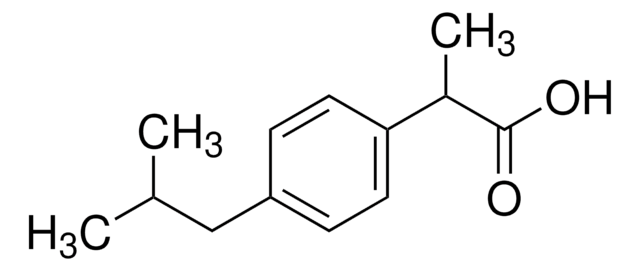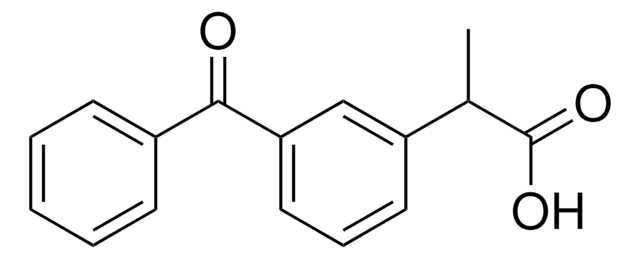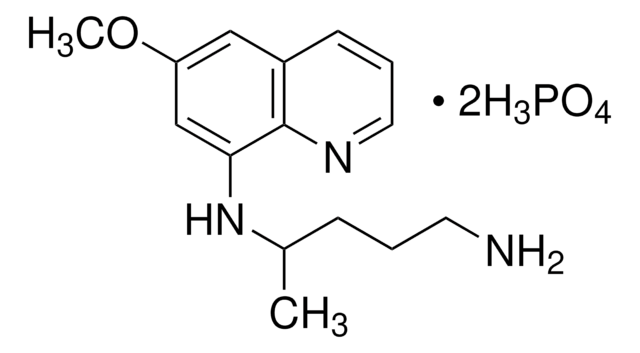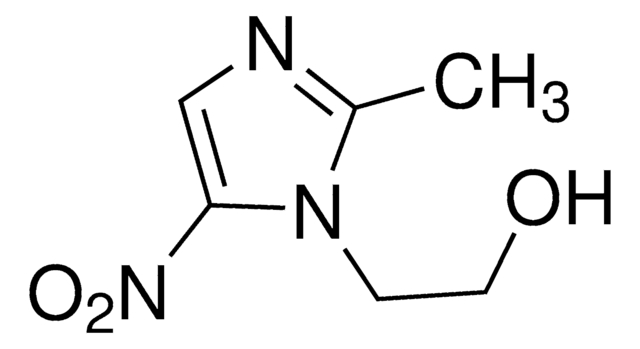I3132
Indoprofen
analytical standard
Sinónimos:
α-Methyl-p-(1-oxo-2-isoindolinyl)benzeneacetic acid
About This Item
Productos recomendados
grado
analytical standard
Nivel de calidad
técnicas
HPLC: suitable
gas chromatography (GC): suitable
aplicaciones
forensics and toxicology
pharmaceutical (small molecule)
veterinary
formato
neat
cadena SMILES
CC(C(O)=O)c1ccc(cc1)N2Cc3ccccc3C2=O
InChI
1S/C17H15NO3/c1-11(17(20)21)12-6-8-14(9-7-12)18-10-13-4-2-3-5-15(13)16(18)19/h2-9,11H,10H2,1H3,(H,20,21)
Clave InChI
RJMIEHBSYVWVIN-UHFFFAOYSA-N
Información sobre el gen
human ... IL8RA(3577) , PTGS1(5742) , PTGS2(5743)
Aplicación
Indoprofen may be used as an analytical reference standard for the quantification of the analyte in biological samples and pharmaceutical formulations using different chromatography techniques.
Aplicación
Palabra de señalización
Danger
Frases de peligro
Consejos de prudencia
Clasificaciones de peligro
Acute Tox. 3 Oral - Carc. 2
Código de clase de almacenamiento
6.1C - Combustible acute toxic Cat.3 / toxic compounds or compounds which causing chronic effects
Clase de riesgo para el agua (WGK)
WGK 3
Punto de inflamabilidad (°F)
Not applicable
Punto de inflamabilidad (°C)
Not applicable
Equipo de protección personal
Eyeshields, Faceshields, Gloves, type P3 (EN 143) respirator cartridges
Elija entre una de las versiones más recientes:
Certificados de análisis (COA)
¿No ve la versión correcta?
Si necesita una versión concreta, puede buscar un certificado específico por el número de lote.
¿Ya tiene este producto?
Encuentre la documentación para los productos que ha comprado recientemente en la Biblioteca de documentos.
Nuestro equipo de científicos tiene experiencia en todas las áreas de investigación: Ciencias de la vida, Ciencia de los materiales, Síntesis química, Cromatografía, Analítica y muchas otras.
Póngase en contacto con el Servicio técnico



![[2-(Acryloyloxy)ethyl]trimethylammonium chloride solution 80 wt. % in H2O, contains 600 ppm monomethyl ether hydroquinone as inhibitor](/deepweb/assets/sigmaaldrich/product/structures/393/326/f7e19585-5431-4220-81b5-f458de6d63d0/640/f7e19585-5431-4220-81b5-f458de6d63d0.png)




